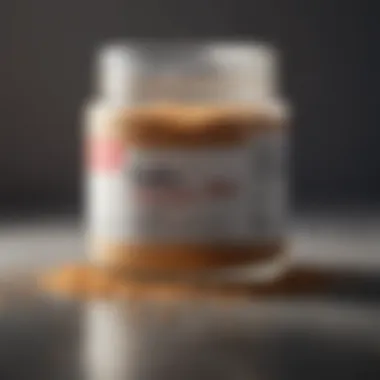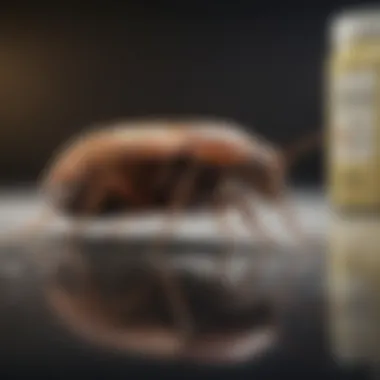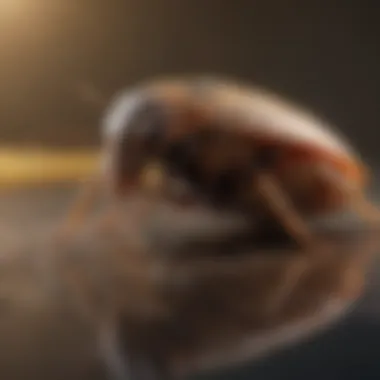Boric Acid for Cockroaches: A Smart Pest Control Choice


Intro
Boric acid is a compound that has gained attention as a remarkably effective solution in managing cockroach infestations. These pests are not merely a nuisance; they are also carriers of various diseases, which makes controlling them crucial for maintaining a healthy home environment. Understanding how boric acid acts against cockroaches can aid homeowners and pest control professionals alike in making informed decisions about pest management strategies.
In this article, we will cover several key aspects related to boric acid’s role in controlling cockroach populations. We will examine how to identify these pests effectively, delve into preventive strategies to keep them at bay, and provide thorough treatment options. This comprehensive overview ensures that readers not only learn about boric acid but also gain insight into a broader approach to pest control.
Preface to Pest Control
Pest control is a crucial aspect of maintaining a healthy home environment. The presence of pests, particularly cockroaches, can lead to various health risks and may indicate underlying sanitation issues. Understanding pest control is vital for both homeowners and pest management professionals. It allows for effective strategies to combat infestations, safeguarding well-being and property value.
Understanding Pest Infestations
Pest infestations occur when pest species, such as cockroaches, proliferate in an area, causing disruption and potential harm. Factors contributing to these infestations include food sources, moisture, and shelter. Homeowners must identify these elements to implement successful interventions.
Signs of an infestation include droppings, shed skins, and visible cockroach activity. Monitoring and recognizing these indicators early can prevent larger infestations.
Impact of Cockroaches on Public Health
Cockroaches are more than just a nuisance; they pose significant health risks. They carry various pathogens that can lead to serious illnesses. Allergens produced by cockroaches can trigger asthma and allergic reactions, particularly in sensitive populations like children and the elderly.
Their droppings and body parts can contaminate food and surfaces, leading to foodborne illnesses. Cockroaches are vectors for diseases such as Salmonella and E. coli, emphasizing the need for effective pest control measures.
Understanding the risks associated with cockroach infestations is essential. Taking proactive steps ensures a safe living environment and protects against the potential consequences of these pests.
Overview of Boric Acid
Boric acid is a key player in pest control, particularly when targeting cockroaches. Understanding its properties and history is essential for anyone dealing with pest problems in their home. This section highlights the chemical composition of boric acid and its historical context, shedding light on why it is considered an effective solution.
Chemical Composition and Properties
Boric acid, with the chemical formula H₃BO₃, consists of boron, oxygen, and hydrogen. It appears as a white, odorless powder. Although it is a weak acid, its unique properties make it effective against pests like cockroaches. When cockroaches ingest boric acid, it disrupts their digestive systems, causing dehydration and death. Additionally, it can affect them physically by adhering to their exoskeleton, leading to further deterioration.
Notably, boric acid is also hygroscopic. This means it can absorb moisture from the environment. Such a quality enhances its effectiveness, as cockroaches thrive in moist habitats. In areas where boric acid is applied, the moisture attracts cockroaches, who then consume it along with the substance itself, leading to toxic effects.
Understanding these chemical properties is crucial for effective application and ensuring that the right dosage is used to maximise its effectiveness while minimizing potential risks to humans and pets.
Historical Use in Pest Control
The use of boric acid in pest management dates back to the late 19th century. Initially, it served as a fumigant for various pests. Over the years, pest control experts recognized its efficiency against cockroaches specifically. Unlike many synthetic chemicals, boric acid has a lower toxicity for humans and pets when handled properly, making it an attractive option.
Historically, boric acid was used in various household products, enhancing its reach. For instance, it is found in some cleaning solutions and insecticides. This multifaceted use underscores its longstanding reputation as a versatile pest control agent.
The paradigm of pest management has evolved. As homeowners prioritize safety and environmental considerations, naturally occurring compounds like boric acid have become more favored over harsher chemicals. The appeal of using boric acid lies in its effective yet gentle approach to pest control, showcasing its importance in both modern and traditional pest management strategies.
Mechanism of Action Against Cockroaches
Understanding the mechanism of action of boric acid against cockroaches is vital in comprehending its effectiveness in pest control. This section unravels the processes by which boric acid affects these insects, showcasing why it is a preferred option for many homeowners and pest management professionals. Knowledge of this mechanism enables informed application, maximizing its benefits and ensuring optimal results in combating infestations.
The Ingestion Process


Boric acid acts primarily through ingestion, making it crucial for the cockroach to consume the substance. When cockroaches encounter boric acid, either on treated surfaces or in bait formulations, they inadvertently ingest it while grooming themselves or feeding. This behavior is typical for these insects, as they often clean their exoskeletons and explore their environment with their mouthparts.
During this process, the fine powder of boric acid adheres to the cockroach’s body and then enters its digestive system. It's essential that homeowners correctly place the bait in the right areas, as this significantly increases the chances that cockroaches will consume it. Properly identifying high-traffic locations is key to ensuring effective boric acid application and reduces the chances of the product being left unattended.
Toxic Impact on the Insect System
Once ingested, boric acid has a detrimental effect on the cockroach’s physiological functions. It disrupts the insect’s digestive processes and affects its overall metabolic balance. This acid serves as a stomach poison, leading to starvation, as cockroaches cannot efficiently absorb nutrients after consumption.
Moreover, boric acid has been shown to cause dehydration in cockroaches. It disrupts transpiration, affecting their ability to retain necessary fluids in their bodies. As they become increasingly dehydrated, it compounds the toxic effects, ultimately leading to their demise. The entire process can take several days, allowing the cockroach to spread boric acid to other individuals, enhancing its efficacy through secondary poisoning.
"Boric acid is a slow-acting poison, which is beneficial for controlling not just individual cockroaches but also entire infestations."
This aspect of boric acid usage is significant in pest management. Homeowners must be aware that the visible decrease in cockroach activity may not be instantaneous; however, the long-term effects are profound. Effective targeting and understanding of this mechanism underpin why boric acid continues to be a go-to solution in the ongoing battle against cockroach invasions.
Application of Boric Acid for Cockroach Control
The application of boric acid serves as a critical aspect of managing cockroach populations effectively. Proper application not only ensures maximized efficacy, but also enhances safety for humans and pets. This section covers major components like identifying infested areas, application methods and their respective frequency and timing.
Identifying Infested Areas
Understanding where cockroaches are likely to inhabit is essential for effective pest control. Cockroaches prefer warm, dark places where food and moisture are abundant. Common infested areas include kitchens, bathrooms, and basements. Inspecting behind appliances, under sinks, and around plumbing fixtures is crucial. By pinpointing these areas, homeowners can focus treatment efforts there and use resources more efficiently.
Methods of Application
The way boric acid is applied plays a significant role in its effectiveness. There are various methods, each bringing its own benefits and considerations. The most common application methods include powder formulation, boric acid baits, and liquid solutions.
Powder Formulation
Powder formulation stands out due to its ease of use and penetrative ability. This form allows the boric acid to settle into cracks and crevices, thus reaching cockroaches where they often hide. A key characteristic of the powder is its durability, which allows it to persist in treated areas longer than other applications. However, while it is popular among users, care must be taken to keep it away from children and pets, as it can pose health risks.
Boric Acid Baits
Boric acid baits combine boric acid with food-based attractants. This method capitalizes on the cockroaches' behavior, as they will consume the bait and return to their nesting areas. A significant selling point is that baits can reduce the visible cockroach population noticeably within a short period. Nevertheless, effectiveness can be compromised if other food sources are present nearby, leading to reduced bait consumption.
Liquid Solutions
Liquid solutions offer quick effects as they can immediately act upon contact. This method allows for thorough application in various settings, like along baseboards or corners. The ease of application makes it appealing, but liquid solutions often require more frequent reapplication compared to other methods. Their use also necessitates caution, as they can be harmful if ingested by children or pets.
Frequency and Timing of Application
The efficacy of boric acid largely depends on when and how often it is applied. Ongoing monitoring of treated areas is necessary to determine when reinfestation occurs. Typically, reapplication should occur every few weeks, especially in heavily infested locations. Utilizing boric acid during peak cockroach activity times, often late spring to early fall, can optimize results. Regular inspections and timely applications can provide a robust defense against future infestations.
Advantages of Using Boric Acid
Boric acid has gained popularity as a viable option for managing cockroach infestations. Understanding its advantages is crucial for homeowners seeking effective pest control solutions. This section explores specific benefits, offering a nuanced view of boric acid’s role in pest management.
Cost-Effectiveness
One of the standout features of boric acid is its cost-effectiveness. Compared to many commercial pesticide options, boric acid is relatively inexpensive. Homeowners can purchase it in powder form or as pre-mixed baits at an affordable price.
Moreover, a small amount of boric acid can cover a large area. Its efficacy means that fewer applications may be needed compared to other treatments. This aspect makes it a financially attractive solution, especially for those dealing with recurrent infestations. Regular maintenance costs are minimal, further reinforcing its appeal to budget-conscious individuals.


Long-Lasting Effects
Boric acid is known for its longevity in contaminated environments. Once applied, the powder can remain effective for several months, as long as it is not disturbed by frequent cleaning or water exposure. This durability allows homeowners to achieve sustained pest control without the need for constant reapplication.
The slow-acting nature of boric acid also plays a critical role in its effectiveness. When ingested by cockroaches, it disrupts their biological processes over time. This gradual impact can lead to reduced population levels, as it not only kills the initial cockroaches but can also eliminate others that consume the bait or powder indirectly.
Environmental Considerations
Another significant advantage of using boric acid is its relatively low environmental impact. Unlike many synthetic pesticides, boric acid is often regarded as a more eco-friendly alternative. It breaks down over time and poses a lower risk to non-target species, making it a safer option in homes around children and pets.
Homeowners can implement boric acid treatments without contributing to the widespread use of harmful chemicals that adversely affect ecosystems. This quality resonates with individuals focused on sustainable living and responsible pest control while maintaining household safety.
Boric acid serves as a dual-purpose solution, effectively combating cockroach problems while remaining considerate of health and environmental effects.
In summary, the advantages of using boric acid for cockroach control encompass cost-effectiveness, long-lasting effects, and environmental safety. Understanding these benefits can guide homeowners in making informed pest management decisions.
Disadvantages and Limitations
While boric acid is recognized for its efficacy in combating cockroach infestations, it is crucial to acknowledge certain disadvantages and limitations associated with its usage. Understanding these factors enables homeowners and pest control professionals to make informed decisions when selecting pest management strategies. An effective pest control approach requires an awareness of potential shortcomings, ensuring that boric acid is both appropriately applied and supplemented with other control methods when necessary.
Potential Resistance in Cockroaches
Cockroaches are known for their adaptability, which may lead to potential resistance to boric acid over time. Some studies indicate that when certain populations of cockroaches are consistently exposed to a particular insecticide, including boric acid, they may develop behavioral or physiological changes to survive. This resistance poses a significant challenge for pest management efforts, as it can render traditional methods less effective.
Studies suggest that the effectiveness of boric acid can diminish as cockroach populations adapt.
To mitigate this risk, it is imperative for homeowners to rotate pest control products regularly and implement an integrative approach. This may include integrating boric acid treatments with bait, traps, and even professional extermination services when necessary.
Health Risks to Humans and Pets
Another consideration in using boric acid is the potential health risks it may pose to humans and pets. Although boric acid is generally considered low in toxicity, improper handling or ingestion can lead to health complications. It can cause irritation to the skin, eyes, and respiratory tract. Ingesting significant amounts may lead to gastrointestinal distress and other health issues.
Homeowners should exercise caution when applying boric acid, ensuring that it is placed in areas inaccessible to children or pets. Proper usage guidelines should always be followed to minimize exposure risks. Storing boric acid safely and labeling the areas of application is essential for optimal safety.
Limited Effectiveness in Large Infestations
While boric acid can offer substantial benefits for controlling cockroach populations, its effectiveness may be limited in cases of large infestations. In high-density situations, boric acid may not sufficiently reduce the population due to the sheer number of insects present. Cockroaches might avoid areas treated with boric acid, further hindering effective treatment.
In such cases, a multifaceted approach is necessary. Alongside boric acid, integrating other pest control measures such as traps, insecticides, and professional pest control services will be more effective in managing extensive infestations. Regular inspections and preventive measures also play a vital role in reducing the likelihood of future infestations.
Safety Considerations for Home Use
Understanding safety is crucial when using boric acid for cockroach management. While boric acid is an effective pest control method, improper handling and storage can lead to health concerns. This section discusses essential factors to ensure safe use in a home environment.
Proper Handling and Storage
When working with boric acid, adhering to safety guidelines minimizes risks. Here are key practices for proper handling:
- Wear Safety Gear: Always use gloves and a mask to avoid inhaling dust or direct skin contact. This is especially important when applying boric acid powder.
- Use Appropriate Containers: Store boric acid in its original container, tightly sealed. A label-free container can lead to mistakes, so keep clear identification.
- Keep Out of Reach: Store boric acid in a secure location, away from children and pets. It is essential to educate household members about the importance of not accessing pest management products.
- Avoid Food Areas: When applying boric acid, ensure it does not come in contact with food or food preparation surfaces. This is to maintain food safety and prevent accidental ingestion.


Following these practices contributes to responsible pest management while reducing health risks associated with boric acid exposure.
Signs of Toxic Reaction
Despite its effectiveness, users should remain vigilant for any signs of adverse reactions, either in themselves or animals. Here are common symptoms to observe:
- Respiratory Issues: Difficulty breathing or coughing may indicate an allergic reaction or irritation caused by boric acid dust.
- Nausea: Feeling sick or having an upset stomach could be a sign of ingestion, which should prompt immediate action.
- Skin Irritation: Redness, itching, or rash on skin areas where boric acid has made contact suggests irritation and requires proper cleaning and care.
If any of these signs appear, it is vital to seek medical attention. It is better to err on the side of caution when dealing with chemical substances.
"Safety should always be a priority when implementing pest control solutions in your household."
Comparative Analysis with Other Pest Control Methods
When dealing with cockroach infestations, understanding various pest control methods is essential for homeowners. This section evaluates how boric acid measures against other commonly used methods. Each method has its distinct characteristics, benefits, and drawbacks. Knowing these can enhance decision-making when selecting a pest management strategy.
Chemical Pesticides
Chemical pesticides are widely used in pest management due to their quick results. Products like Raid or Ortho provide immediate knockdown of cockroach populations. However, reliance on these pesticides comes with certain concerns. For instance, many chemical products contain ingredients that may pose health risks to humans and pets. Furthermore, there is ongoing concern about the potential for pests to develop resistance to these chemicals over time. Therefore, over-reliance on chemical pesticides can lead to diminishing effectiveness.
"Resistance is a significant issue in pest control, necessitating the exploration of alternative methods like boric acid."
Another crucial factor is environmental impact. Chemical pesticides can contaminate soil and water. In contrast, boric acid is generally regarded as safer for the environment and less toxic than many traditional pesticides. In terms of linger effects, chemical pesticides may require more frequent re-application, adding to costs and potential hazards.
Natural Alternatives
Natural alternatives are increasingly popular among homeowners who seek eco-friendly pest management options. These methods are often seen as safer for both the environment and household members. Among the natural alternatives, two stand out: Diatomaceous Earth and Essential Oils.
Diatomaceous Earth
Diatomaceous Earth consists of fossilized aquatic organisms, known as diatoms. This powder is effective against insects, including cockroaches. The unique characteristic of Diatomaceous Earth lies in its physical action. When insects come into contact with it, the powder scratches their exoskeleton, causing dehydration and eventual death. This makes it a beneficial choice in pest management because it offers a mechanical kill method without chemicals. It also holds an advantage in safety for humans and pets, being non-toxic when handled properly.
However, there are limitations. Diatomaceous Earth works best in dry environments, meaning areas with moisture may lessen its effectiveness. Additionally, it needs to be applied carefully to avoid disturbing the powder, which can cause it to lose its effectiveness.
Essential Oils
Essential Oils, derived from various plants, provide another natural alternative. Many oils, like peppermint or tea tree, are known for their insect-repelling properties. These oils are advantageous due to their pleasant scents, making them more appealing in home environments. They also offer an eco-friendly solution with low toxicity risk.
One unique feature of Essential Oils is their ability to mask scents that draw cockroaches. This masking effect makes it a valuable method for control. However, their effectiveness can be inconsistent. Essential Oils may require frequent applications and sometimes may not provide the same level of immediate impact as other methods.
In summary, a comparative analysis helps to highlight the strengths and weaknesses of various pest control methods. Boric acid offers a middle ground by being effective, cost-efficient, and relatively safe compared to chemical alternatives. Evaluating these methods lays groundwork for informed choices in pest management.
Closure
The discussion surrounding boric acid as a solution for cockroach infestations reveals its significance in pest management. Understanding the role of boric acid enables homeowners to make more informed choices when facing pest issues. With its unique capacity to disrupt cockroach physiology and behavior, boric acid holds a vital place in pest control strategies.
Summary of Key Points
In evaluating boric acid for cockroach management, several critical points come to light:
- Effectiveness: Boric acid is proven effective due to its mechanism of action, where it targets the insect's digestive system, ultimately leading to mortality.
- Application Methods: Various forms such as powder, baits, and liquid solutions allow flexibility in addressing different infestation scenarios.
- Cost-Effectiveness: Boric acid is relatively inexpensive compared to other pest control measures while offering lasting results.
- Environmental Impact: It poses fewer risks to the environment and humans compared to many chemical pesticides, which is an essential consideration for many homeowners.
- Challenges: Despite its advantages, issues such as potential cockroach resistance and health risks underscore the need for careful application and education.
Future Directions in Pest Control Research
As pest control continues to evolve, the following areas merit further investigation:
- Resistance Studies: Ongoing research is essential to understand how cockroaches develop resistance to boric acid and other common treatments. Identifying genetic or behavioral changes can guide future application methods.
- Combination Approaches: Examining the synergistic effects of boric acid with other natural and chemical methods may lead to more effective pest control protocols.
- Safety Enhancements: Developing safer formulations or delivery methods could minimize health risks for pets and humans while retaining effectiveness.
- Public Awareness: Increasing awareness about the safe use of boric acid in pest management helps homeowners utilize this tool effectively and responsibly.



